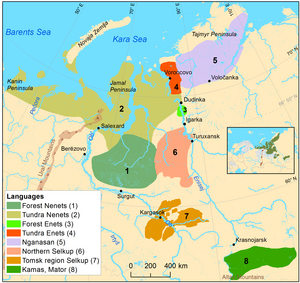Samoyedic languages
| Samoyedic | |
|---|---|
| Samoyed | |
| Geographic distribution | Northern Eurasia |
| Linguistic classification | Uralic
|
| Proto-language | Proto-Samoyedic |
| Subdivisions | |
| ISO 639-5 | syd |
| Glottolog | samo1298 |
 Samoyedic languages at the beginning of the 20th century | |
 Current geographic distribution of Samoyedic languages in Russia | |
The Samoyedic (
Etymology
The term Samoyedic is derived from the Russian term samoyed (Russian: самоед) for some indigenous peoples of Siberia. The term has come to be considered derogatory because it has been interpreted by some ethnologists as originating from Russian samo-yed meaning 'self-eater', i.e. 'cannibal'.[5]
Another suggestion for the term's origin is a corruption of the expression saam-edne, meaning "Land of the
The word Samodeic[7] has been proposed as an alternative by some ethnologists.[5]
Classification
Traditionally, Samoyedic languages and peoples have been divided into two major areal groups: Northern Samoyedic (Nenets, Yurats, Enets, Nganasans), and Southern Samoyedic (Selkups) with a further subgroup of Sayan-Samoyedics (Kamasins, Mators) named after the Sayan Mountains. They are however purely geographical, and do not reflect linguistic relations.
Linguistic genealogical classifications point to an early divergence of Nganasan and (perhaps to a lesser degree) Mator, with Enets–Nenets–Yurats and Kamas–Selkup forming internal branches.[4]
- Samoyedic
- Nganasan (Tavgi or Tawgi-Samoyed)
- Avam
- Vadey/Vadeyev
- Core-Samoyedic
- Mator (Sayan-Samoyed) †
- Taigi
- Karagass
- Soyot (Modern Soyots were subject to Turkificationand do not speak the historical language)
- Nganasan (Tavgi or Tawgi-Samoyed)
Grammar
Samoyedic languages are primarily
Säxäko
Seheko
boľńica-xana
hospital-LOC
me
be.[3SG]
"Seheko is in the hospital."
Nouns
Nouns in Samoyedic languages do not have gender, but they are declined for number (singular, dual, and plural) as well as case.[9] All Samoyedic languages have at least seven noun cases which may include nominative, genitive, dative, accusative, ablative, locative, instrumental, lative, and/or prolative depending on the language.[9][10]
Verbs
Many Samoyedic languages have the following three conjugation types: subjective, objective (in which the number of the object is expressed in addition to that of the subject), and reflexive.[10] Verbs in Samoyedic languages have several moods, ranging from at least eight in Selkup to at least sixteen in Nenets. Other forms of verbs that can be found in Samoyedic languages are gerunds, participles, and infinitives. Of the Samoyedic languages, only Selkup has verbal aspect.[8]
Phonology
Sonorant-obstruent consonant clusters with two consonants, of which the latter consonant is more sonorous than the former, are the most frequently occurring consonant clusters in several Samoyedic languages. Conversely, consonant clusters ending in glides are not found in any Samoyedic languages.[12]
Unlike some other Uralic languages, Samoyedic languages do not have vowel harmony.[10]
Vowel epenthesis is frequently used in Samoyedic languages to break up consonant clusters, particularly in the case of loanwords borrowed from Russian.[12]
Vowel epenthesis from Russian to Nenets[12]
- крупа (krupa) > xurupa "cereals"
- класс (klass) > xalas "class"
Vowel epenthesis from Russian to Nganasan[12]
- бригада (brigada) > birigadә "brigade"
- метр (metr) > metәrә "meter"
Vowel epenthesis from Russian to Selkup[12]
- стекло (stʲeklo) > tʲekɨla "glass"
- стол (stol) > istol "table"
Contact with Russian language
Samoyedic languages have experienced significant language contact with Russian to such an extent that members of the Nenets, Selkup, Nganasan, and Enets ethnic groups now often have Russian as a first language, with speakers of Samoyedic languages primarily belonging to elder age groups.[12]
Russian loanwords in Samoyedic languages include: колхоз ("collective farm"), машина ("car"), молоко ("milk"), Москва ("Moscow").[12]
Geographical distribution
At present, Samoyed territory extends from the
The Southern Samoyedic languages, of which only the
References
- ^ "Samoyedic". Lexico UK English Dictionary. Oxford University Press. Archived from the original on 2020-09-26.
- ^ "Samoyed". Lexico UK English Dictionary. Oxford University Press. Archived from the original on 2022-08-27.
- ^ "Samoyed". Merriam-Webster.com Dictionary. Retrieved 2016-01-21.
- ^ a b Janhunen, Juha (1998). "Samoyedic". In Daniel Abondolo (ed.). The Uralic Languages. London / New York: Routledge. pp. 457–479.
- ^ ISBN 9780691228112.
... I use the linguistic term Samodeic here, since it has superseded the more derogatory Samoyedic. In Russian, 'Samoyed' originally meant 'self-eater' before it became a general enthnolinguistic term for the group encompassing Nentsy, Entsy, Nganasan, and Sel'kup (cf. Comrie 1981; Golovnev 1995)...
- ISBN 9781487591113.
... The term 'Samoyeds' had no derogatory meaning (1) and, as can be surmised, represents a modification of the expression 'same-edne' i.e. 'land of the Saams.' This term was transferred from the Saam tribes (which evidently occupied, at one time, the entire north of European Russia) to the Nenets (who appeared there later), and thereafter to the Enets and Ngasans...
- ^ Samodeic @ google books
- ^ JSTOR 26191775.
- ^ a b c Wagner-Nagy, Beata (2016). "Existentials, possessives and definiteness in Samoyedic languages".
- ^ a b c d "The Samoyedic Languages" (PDF). Community of Practice in Uralic Studies (COPIUS). November 30, 2021.
{{cite web}}: CS1 maint: others (link) - ^ Nenyang, M. A. (2005). Russko-neneckij razgovornik [Russian-Nenets Phrase-book]. Sankt-Peterburg: Drofa.
- ^ ISBN 978-1-61451-076-5.
- ) |
External links
 Media related to Samoyedic languages at Wikimedia Commons
Media related to Samoyedic languages at Wikimedia Commons

